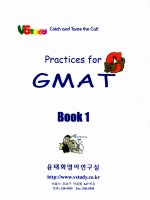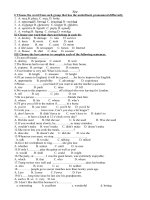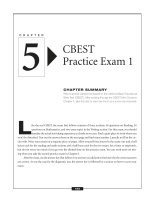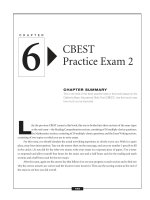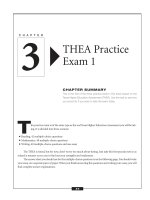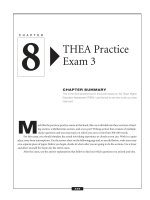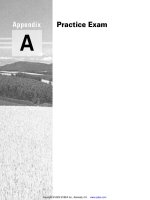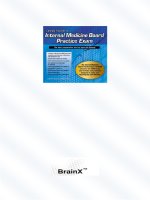CBEST Practice Exam 1
Bạn đang xem bản rút gọn của tài liệu. Xem và tải ngay bản đầy đủ của tài liệu tại đây (269.64 KB, 40 trang )
L
ike the real CBEST, the exam that follows consists of three sections: 50 questions on Reading, 50
questions on Mathematics, and two essay topics in the Writing section. For this exam, you should
simulate the actual test-taking experience as closely as you can. Find a quiet place to work where you
won’t be disturbed. Tear out the answer sheet on the next page and find some number 2 pencils to fill in the cir-
cles with. Write your essays on a separate piece of paper. Allow yourself four hours for the exam: one and a half
hours each for the reading and math sections and a half-hour each for the two essays. Set a timer or stopwatch,
but do not worry too much if you go over the allotted time on this practice exam. You can work more on tim-
ing when you take the second practice exam in Chapter 6.
After the exam, use the answer key that follows it to see how you did and to find out why the correct answers
are correct. As was the case for the diagnostic test, the answer key is followed by a section on how to score your
exam.
CHAPTER
CBEST
Practice Exam 1
CHAPTER SUMMARY
Here is another sample test based on the California Basic Educational
Skills Test (CBEST). After working through the CBEST Mini-Course in
Chapter 4, take this test to see how much your score has improved.
5
155
–
LEARNINGEXPRESS CALIFORNIA BASIC EDUCATIONAL SKILLS TEST ANSWER SHEET
–
157
1. abcde
2. abcde
3. abcde
4. abcde
5. abcde
6. abcde
7. abcde
8. abcde
9. abcde
10. abcde
11. abcde
12. abcde
13. abcde
14. abcde
15. abcde
16. abcde
17. abcde
18. abcde
19. abcde
20. abcde
21. abcde
22. abcde
23. abcde
24. abcde
25. abcde
26. abcde
27. abcde
28. abcde
29. abcde
30. abcde
31. abcde
32. abcde
33. abcde
34. abcde
35. abcde
36. abcde
37. abcde
38. abcde
39. abcde
40. abcde
41. abcde
42. abcde
43. abcde
44. abcde
45. abcde
46. abcde
47. abcde
48. abcde
49. abcde
50. abcde
1. abcde
2. abcde
3. abcde
4. abcde
5. abcde
6. abcde
7. abcde
8. abcde
9. abcde
10. abcde
11. abcde
12. abcde
13. abcde
14. abcde
15. abcde
16. abcde
17. abcde
18. abcde
19. abcde
20. abcde
21. abcde
22. abcde
23. abcde
24. abcde
25. abcde
26. abcde
27. abcde
28. abcde
29. abcde
30. abcde
31. abcde
32. abcde
33. abcde
34. abcde
35. abcde
36. abcde
37. abcde
38. abcde
39. abcde
40. abcde
41. abcde
42. abcde
43. abcde
44. abcde
45. abcde
46. abcde
47. abcde
48. abcde
49. abcde
50. abcde
Section 1: Reading Comprehension
Section 2: Mathematics
Section 1: Reading Comprehension
Answer questions 1–8 on the basis of the following
passage.
(1) Produced in 1959, Lorraine Hansberry’s play, A
Raisin in the Sun, was a quietly revolutionary work
that depicted African-American life in a fresh, new,
and realistic way. The play made her the youngest
American, the first African-American, and the fifth
woman to win the New York Drama Critic’s Circle
Award for Best Play of the Year. In 1961, it was pro-
duced as a film starring Sydney Poitier and has since
become a classic, providing inspiration for an
entire generation of African-American writers.
(2) Hansberry was not only an artist but also a
political activist and the daughter of activists. Born
in Chicago in 1930, she was a member of a promi-
nent family devoted to civil rights. Her father was a
successful real-estate broker, who won an anti-seg-
regation case before the Illinois Supreme Court in
the mid-1930s, and her uncle was a Harvard pro-
fessor. In her home, Hansberry was privileged to
meet many influential cultural and intellectual lead-
ers. Among them were artists and activists such as
Paul Robeson, W.E.B. DuBois, and Langston
Hughes.
(3) The success of A Raisin in the Sun helped gain
an audience for her passionate views on social jus-
tice. It mirrors one of Hansberry’s central artistic
efforts, that of freeing many people from the
smothering effects of stereotyping by depicting the
w
ide array of personality types and aspirations that
exist within one Southside Chicago family. A Raisin
in the Sun was followed by another play, produced
in 1964, The Sign in Sidney Brustein’s Window. This
play is about an intellectual in Greenwich Village,
New York City, a man who is open-minded and
generous of spirit who, as Hansberry wrote, “cares
about it all. It takes too much energy not to care.”
(4) Lorraine Hansberry died on the final day of
the play’s run on Broadway. Her early death, at the
age of 34, was unfortunate, as it cut short a brilliant
and promising career, one that, even in its short
span, changed the face of American theater. After
her death, however, her influence continued to be
felt. A dramatic adaptation of her autobiography, To
Be Young, Gifted, and Black, consisted of vignettes
based on Hansberry’s plays, poems, and other writ-
ings. It was produced Off-Broadway in 1969 and
appeared in book form the following year. Her play,
Les Blancs, a drama set in Africa, was produced in
1970; and A Raisin in the Sun was adapted as a
musical, Raisin, and won a Tony award in 1973.
(5) Even after her death, her dramatic works have
helped gain an audience for her essays and speeches
on wide-ranging topics, from world peace to the
evils of the mistreatment of minorities, no matter
what their race, and especially for her works on the
civil-rights struggle and on the effort by Africans to
be free of colonial rule. She was a woman, much like
the characters in her best-known play, who was
determined to be free of racial, cultural, or gender-
based constraints.
1. The writer of the passage suggests that Hans-
berry’s political beliefs had their origins in her
experience as
a. the daughter of politically active parents.
b. a successful playwright in New York.
c. a resident of Southside Chicago.
d. an intellectual in Greenwich Village.
e. a civil rights activist.
–
CBEST PRACTICE EXAM 1
–
159
2. The main purpose of the passage is to
a. praise Lorraine Hansberry’s writings and
illustrate their artistic and political influence.
b. summarize Lorraine Hansberry’s best-known
works.
c. demonstrate that if one is raised in a well-
educated family, such as Lorraine Hansberry’s,
one is likely to succeed.
d. show Lorraine Hansberry’s difficult struggle
and ultimate success as a young female writer.
e. persuade students to read A Raisin In The Sun.
3. Hansberry’s father earned his living as
a. a civil-rights worker.
b. a banker.
c. a real-estate broker.
d. an artist and activist.
e. an attorney.
4. Paragraph 3 suggests that Hansberry’s main pur-
pose in writing A Raisin in the Sun was to
a. win her father’s approval.
b. break down stereotypes.
c. show people how interesting her own family
was.
d. earn the right to produce her own plays.
e. win a Best Play award.
5. By including paragraphs 4 and 5, the author
most likely intended to show that
a. the civil-rights struggle continued even after
Hansberry died.
b. Hansberry actually wrote more poems and
essays than she did plays.
c. Raisin in the Sun was more successful after
Hansberry’s death than it was before she died.
d. Hansberry’s work continued to influence peo-
ple even after her death.
e. Hansberry died unusually young.
6. According to the passage, how many women had
won the New York Drama Critic’s Circle Award
for Best Play of the Year before Lorraine Hans-
berry did?
a. none
b. one
c. four
d. five
e. six
7. As it is used in paragraph 3, the underlined
phrase wide array most nearly means
a. variety.
b. gathering.
c. arrangement.
d. decoration.
e. features.
8. According to the passage, which of the following
dramatic works was based most directly on
Hansberry’s life?
a. A Raisin in the Sun
b. Les Blancs
c. The Sign in Sidney Brustein’s Window
d.
To Be Young, Gifted, and Black
e. the musical Raisin
Answer question 9 on the basis of the following
passage.
Moscow has a history of chaotic periods of war
that ended with the destruction of a once largely
wooden city and the building of a “new” city on top of
the rubble of the old. The result is a layered city, with
each tier holding information about a part of Russia’s
past. In some areas of the city, archaeologists have
reached the layer from 1147, the year of Moscow’s
founding. Among the findings from the various peri-
ods of Moscow’s history are carved bones, metal tools,
pottery, glass, jewelry, and crosses.
–
CBEST PRACTICE EXAM 1
–
160
9. From the passage, the reader can infer that
a. the people of Moscow are more interested in
modernization than in preservation.
b. the Soviet government destroyed many of the
historic buildings in Russia.
c. Moscow is the oldest large city in Russia,
founded in 1147.
d. Moscow has a history of invasions, with each
new conqueror razing past structures.
e. Moscow has endured many periods of upris-
ing and revolution.
Answer questions 10–13 on the basis of the follow-
ing passage.
Heat reactions usually occur when large amounts
of water and/or salt are lost through excessive sweating
following strenuous exercise. When the body becomes
overheated and cannot eliminate this excess heat, heat
exhaustion and heat stroke are possible.
Heat exhaustion is generally characterized by
clammy skin, fatigue, nausea, dizziness, profuse per-
spiration, and sometimes fainting, resulting from an
inadequate intake of water and the loss of fluids. First
aid treatment for this condition includes having the
victim lie down, raising the feet 8–12 inches, applying
cool, wet cloths to the skin, and giving the victim sips
of salt water (1 teaspoon per glass, half a glass every 15
minutes), over the period of an hour.
Heat stroke is much more serious; it is an imme-
diately life-threatening situation. The characteristics of
heat stroke are a high body temperature (which may
reach 106°F or more); a rapid pulse; hot, dry skin; and
a blocked sweating mechanism. Victims of this condi-
tion may be unconscious, and first aid measures
should be directed at cooling the body quickly. The
victim should be placed in a tub of cold water or
repeatedly sponged with cool water until his or her
temperature is lowered sufficiently. Fans or air condi-
tioners will also help with the cooling process. Care
should be taken, however, not to overchill the victim
once the temperature is below 102°F.
10. The most immediate concern of a person tend-
ing a victim of heat stroke should be to
a. get salt into the victim’s body.
b. raise the victim’s feet.
c. lower the victim’s pulse rate.
d. have the victim lie down.
e. lower the victim’s temperature.
11. Which of the following is a symptom of heat
exhaustion?
a. unconsciousness
b. excessive sweating
c. hot, dry skin
d. a weak pulse
e. a rapid pulse
12. Heat stroke is more serious than heat exhaustion
because heat stroke victims
a. have too little salt in their bodies.
b. cannot take in water.
c. do not sweat.
d. have frequent fainting spells.
e. may have convulsions.
13. On the basis of the information in the passage,
symptoms such as nausea and dizziness in a heat
exhaustion victim indicate that the person most
likely needs to
a. be immediately taken to a hospital.
b. be immersed in a tub of water.
c. be given more salt water.
d. sweat more.
e. go to an air-conditioned place.
Answer questions 14 and 15 on the basis of the fol-
lowing passage.
Poet William Blake believed that true religion is
revealed through art, not through nature. For Blake, it
–
CBEST PRACTICE EXAM 1
–
161
is through art also that eternity is revealed. One does
not have to die to reach eternity; eternity is the
moment of vision. It is only through the reordering of
sense impressions by the creative imagination that we
are able, as Blake says in his “Auguries of Innocence,”
“To see the World in a Grain of Sand / . . . And Eternity
in an hour.”
14. Which of the following would best describe what
Blake meant by the words “To see the World in a
Grain of Sand / . . . And Eternity in an hour?”
a. a moment of mystical enlightenment
b. conversion to Christianity
c. a moment of artistic inspiration
d. an hallucinatory experience
e. a return to a state of being without sin
15. Which of the following defines Blake’s view of
“nature” as described in the passage?
a. the raw stuff of which the world is made but
which does not represent ultimate reality
b. the work of God in a state of innocence before
it is corrupted by human beings
c. the world made up of base and corrupt mate-
rial before it is changed by the perception of
the artist at the “moment of vision”
d. the temporal world that will perish, as
opposed to the world of artistic vision that
will last forever
e. the real world as it is perceived by ordinary
people, as opposed to the fantasy world of the
artist
Answer questions 16–18 on the basis of the follow-
ing passage.
Businesses today routinely keep track of large
amounts of both financial and non-financial informa-
tion. Sales departments keep track of current and
potential customers; marketing departments keep
track of product details and regional demographics;
accounting departments keep track of financial data
and issue reports. To be useful, all this data must be
organized into a meaningful and useful system. Such a
system is called a management information system,
abbreviated MIS. The financial hub of the MIS is
accounting.
Accounting is the information system that
records, analyzes, and reports economic transactions,
enabling decision-makers to make informed choices
when allocating scarce economic resources. It is a tool
that enables the user, whether a business entity or an
individual, to make wiser, more informed economic
choices. It is an aid to planning, controlling, and eval-
uating a broad range of activities. A financial account-
ing system is intended for use by both the management
of an organization and those outside the organization.
Because it is important that financial accounting
reports be interpreted correctly, financial accounting is
subject to a set of ___________ guidelines called “gen-
erally accepted accounting principles” (GAAP).
16. This passage is most likely taken from
a. a newspaper column.
b. an essay about modern business.
c. a legal brief.
d. a business textbook.
e. a business machine catalog.
17. The word that would fit most correctly into the
blank in the final sentence is
a. discretionary.
b. convenient.
c. instruction.
d. austere.
e. stringent.
–
CBEST PRACTICE EXAM 1
–
162
18. According to the information in the passage,
which of the following is LEAST likely to be a
function of accounting?
a. helping business people make sound judg-
ments
b. producing reports of many different kinds of
transactions
c. assisting with the marketing of products
d. assisting companies in important planning
activities
e. providing information to potential investors
Answer questions 19 and 20 on the basis of the fol-
lowing passage.
The fictional world of Toni Morrison’s novel
Sula—the African-American section of Medallion,
Ohio, a community called “the Bottom”—is a place
where people, and even natural things, are apt to go
awry, to break from their prescribed boundaries, a
place where bizarre and unnatural happenings and
strange reversals of the ordinary are commonplace.
The very naming of the setting of Sula is a turning-
upside-down of the expected; the Bottom is located
high up in the hills. The novel is furthermore filled
with images of mutilation, both psychological and
physical. A great part of the lives of the characters,
therefore, is taken up with making sense of the world,
setting boundaries and devising methods to control
what is essentially uncontrollable. One of the major
devices used by the people of the Bottom is the seem-
ingly universal one of creating a ____________—in
this case, the title character Sula—upon which to proj-
ect both the evil they perceive outside themselves and
the evil in their own hearts.
19. Based on the description of the setting of the
novel Sula, which of the following adjectives
would most likely describe the behavior of many
of its residents?
a. cowardly
b. artistic
c. unkempt
d. arrogant
e. eccentric
20. Which of the following words would BEST fit
into the blank in the final sentence of the
passage?
a. victim
b. hero
c. leader
d. scapegoat
e. outcast
Answer questions 21–23 on the basis of the follow-
ing passage.
Ever since human beings began their conscious
sojourn on this planet, they have puzzled over the rid-
dle of evil and debated its source. Two concepts have
predominated in the debate. The first of these holds
that evil is an active force, a force of darkness as sub-
stantial and powerful as that of light. In terms of the
individual human being, this force might be seen as
the “Shadow” side of the personality, the feared side
that the individual may deny but that is still a real and
integral part of her or him. The second of the two con-
cepts holds that evil is essentially ___________, the
absence of good, that darkness is not a thing in itself
but rather the absence of light. In terms of the indi-
vidual human being, this doctrine says that evil arises
from a lack, a deprivation, from what John A. Sanford
calls “a mutilation of the soul.”
–
CBEST PRACTICE EXAM 1
–
163
21. Which of the following phrases would best fit
into the blank in the third sentence of the
passage?
a. perplexing
b. passive
c. capricious
d. ephemeral
e. artificial
22. The main point of the passage is that
a. human beings have long pondered the enigma
of evil.
b. evil may be viewed as either a natural force or
a human characteristic.
c. there are two long-debated, contradictory
views of evil.
d. human beings are not likely ever to solve the
problem of evil.
e. evil must be understood in order for good to
be appreciated.
23. Which of the following, according to the passage,
does an individual sometimes use to deal with
the “Shadow” side of his or her personality?
a. scorn
b. love
c. acceptance
d. denial
e. projection
Answer questions 24–26 on the basis of the follow-
ing poem by Alfred Lord Tennyson.
The Eagle
He clasps the crag with crooked hands;
Close to the sun in lonely lands,
Ringed with the azure world he stands.
The wrinkled sea beneath him crawls;
He watches from his mountain walls,
And like a thunderbolt he falls.
24. Given the tone of the poem, and noting espe-
cially the last line, what is the eagle MOST likely
doing in the poem?
a. dying of old age
b. hunting prey
c. learning joyfully to fly
d. keeping watch over a nest of young eagles
e. battling another eagle
25. To which of the following do the words “azure
world” most likely refer?
a. a forest
b. the sky
c. the cliff
d. nature
e. God
26. In the second stanza, first line, to which of the
following does the verb “crawls” refer?
a. waves
b. sea creatures
c. sunlight on the water
d. the eagle’s prey
e. the eagle itself
Answer questions 27 and 28 on the basis of the fol-
lowing index from a forest management textbook.
INDEX
fire protection, 51–55, 108, 115
forest conflicts: European, 8, 91–93, 116–117,
133–134, 186–188
forest destruction and ecological decline, 143; and
fire, 31–35; and industrialization, 156–173; and
railways 27–29; and scientific forestry, 60–61; and
villagers, 107, 115–116; and World Wars, 42–43,
46–47
forest fires, 72, 87, 100–105, 124; and pasture, 48,
51–53, 115–118; arson, 51, 122, 126–130; see also
fire protection
forest law: breaches of, 34–41, 49–52, 55, 70,
–
CBEST PRACTICE EXAM 1
–
164
115–116, 121–123; see also forest conflicts
forest management: and agrarian economy, 104–105,
121, 186–189; and imperial needs, 28, 35; and
slash-and-burn farming, 12–18, 48; and commer-
cial orientation of, 30–32; peasant resistance to,
69–76, 89, 99–106
27. On the basis of the index, on which page would
you be most likely to find information about the
outlawed practice of burning forested areas to
create fields for grazing small herds of livestock?
a. page 89
b. page 55
c. page 107
d. page 48
e. page 51
28. On what cause of forest destruction does the
author of the textbook focus most, from the evi-
dence of the index?
a. industrialization
b. fire damage
c. railroads
d. ecological decline
e. scientific forestry
Answer questions 29–31 on the basis of the follow-
ing passage.
1) The Woodstock Music and Art Fair—better
known to its participants and to history simply as
“Woodstock”—should have been a colossal failure.
2) Just a month prior to its August 15, 1969 opening,
the fair’s organizers were informed by the council of
Wallkill, New York, that permission to hold the festival
was withdrawn. 3) Amazingly, not only was a new site
found, but word got out to the public of the fair’s new
location.
4) At the new site, fences that were supposed to
facilitate ticket collection never materialized, and all
attempts at gathering tickets were abandoned. 5)
Crowd estimates of 30,000 kept rising; by the end of
the three days, some estimated the crowd at 500,000.
6) And then, on opening night, it began to rain. 7) Off
and on, throughout all three days, huge summer
storms rolled over the gathering. 8) In spite of these
problems, most people think of Woodstock not only as
a fond memory but as the defining moment for an
entire generation.
29. Which of the following would be the most
appropriate title for this passage?
a. Woodstock as Metaphor
b. Backstage at Woodstock
c. Woodstock: From The Band to The Who
d. Remembering Woodstock
e. Woodstock: The Untold Story
30. Which of the following numbered sentences of
the passage best represents an opinion rather
than a fact?
a. sentence 1
b. sentence 2
c. sentence 3
d. sentence 4
e. sentence 5
31. Why is the word “amazingly” used in sentence 3?
a. because the time in which the move was made
and information sent out was so short
b. because the fair drew such an unexpectedly
enormous crowd
c. because there was such pressure by New York
officials against holding the fair
d. because the stormy weather was so unfavor-
able
e. because ticket-taking was abandoned at the
fair so anyone could come in
–
CBEST PRACTICE EXAM 1
–
165
Answer questions 32–35 on the basis of the follow-
ing passage.
Cuttlefish are intriguing little animals. The cut-
tlefish resembles a rather large squid and is, like the
octopus, a member of the order of cephalopods.
Although they are not considered the most highly
evolved of the cephalopods, they are extremely intelli-
gent. While observing them, it is hard to tell who is
doing the observing, you or the cuttlefish, especially
since the eye of the cuttlefish is very similar in struc-
ture to the human eye. Cuttlefish are also highly
mobile and fast creatures. They come equipped with a
small jet located just below the tentacles that can expel
water to help them move. Ribbons of flexible fin on
each side of the body allow cuttlefish to hover, move,
stop, and start. ______________________________
____________________.
The cuttlefish is sometimes referred to as the
“chameleon of the sea” because it can change its skin
color and pattern instantaneously. Masters of camou-
flage, they can blend into any environment for protec-
tion, but they are also capable of the most imaginative
displays of iridescent, brilliant color and intricate
designs, which scientists believe they use to commu-
nicate with each other and for mating displays. How-
ever, judging from the riot of ornaments and hues
cuttlefish produce, it is hard not to believe they paint
themselves so beautifully just for the sheer joy of it. At
the very least, cuttlefish conversation must be the most
sparkling in all the sea.
32. Which of the following sentences, if inserted into
the blank line, would best sum up the first para-
graph and lead into the next?
a. The cuttlefish can be cooked and eaten like its
less tender relatives, the squid and octopus,
but must still be tenderized before cooking in
order not to be exceedingly chewy.
b. On a scuba dive when you’re observing cuttle-
fish, it is best to move slowly because cuttle-
fish have excellent eyesight and will probably
see you first.
c. Cuttlefish do not have an exoskeleton; instead,
their skin is covered with chromataphors.
d. The cuttlefish has ten arms, two of which are
specialized feeders and its mouth is beak-like;
this enables it to capture crustaceans with its
powerful arms and crack shells with its strong
mouth.
e. By far their most intriguing characteristic is
their ability to change their body color and
pattern.
33. Which of the following is correct according to
the information given in the passage?
a. Cuttlefish are a type of squid.
b. Cuttlefish use jet propulsion as one form of
locomotion.
c. The cuttlefish does not have an exoskeleton.
d. Cuttlefish are the most intelligent
cephalopods.
e. Cuttlefish always imitate the patterns and col-
ors of their environment.
–
CBEST PRACTICE EXAM 1
–
166
34. Which of the following best outlines the main
topics addressed in the passage?
a. I. Explanation of why cuttlefish are intriguing
II. Communication skills of cuttlefish
b. I. Classification and difficulties of observing
cuttlefish
II. Scientific explanation of modes of cuttle-
fish communication
c. I. Explanation of the cuttlefish’s method of
locomotion
II. Description of color displays in mating
behavior
d. I. Comparison of cuttlefish with other
cephalopods
II. Usefulness of the cuttlefish’s ability to
change color
e. I. General classification and characteristics of
cuttlefish
II. Uses and beauty of the cuttlefish’s ability
to change color
35. Which of the following best describes the pur-
pose of the author of the passage?
a. to prove the intelligence of cuttlefish
b. to explain the communication habits of cut-
tlefish
c. to produce a fanciful description of the
“chameleon of the sea”
d. to persuade scuba divers of the interest in
observing cuttlefish
e. to describe the “chameleon of the sea” infor-
matively and entertainingly
Answer question 36 on the basis of the following
passage.
A book proposal has three major functions. First,
it should sell a publisher on the commercial potential
of the as-yet-to-be-written book. Second, the writing
in the proposal itself should convince the publisher
that the author has the ability to write the book.
Finally, the proposal should show that the author has
the background necessary to write the book.
36. Which of the following is the best meaning of
the word “background” as it is used in the
passage?
a. something behind the main event
b. something in a subordinated position
c. one’s ability to do something
d. events leading up to something
e. facts to help explain something
Answer questions 37–40 on the basis of the follow-
ing passage.
Off-site disposal of regulated medical wastes
remains a viable option for smaller hospitals (those
with less than 150 beds). However, some preliminary
on-site processing, such as compaction or hydropulp-
ing, may be necessary prior to sending the wastes
off-site.
Compaction reduces the total volume of solid
wastes, often reducing transportation and disposal
costs, but does not change the hazardous characteris-
tics of the waste. However, compaction may not be
economical if transportation and disposal costs are
based on weight rather than volume. Hydropulping
involves grinding the waste in the presence of an oxi-
dizing fluid, such as hypochlorite solution. One advan-
tage of hydropulping is that waste can be rendered
innocuous and reduced in size within the same system.
Disadvantages are the added operating burden, diffi-
culty of controlling fugitive emission, and the difficulty
of conducting microbiological tests to determine
whether all organic matters and infectious organisms
from the waste have been destroyed.
On-site disposal is a feasible alternative for hos-
pitals generating two tons per day or more total of
solid waste. Common treatment techniques include
steam sterilization and incineration. Although other
–
CBEST PRACTICE EXAM 1
–
167
options are available, incineration is currently the pre-
ferred method for on-site treatment of hospital waste.
A properly designed, maintained, and operated incin-
erator achieves a relatively high level of organism
destruction. Incineration reduces the weight and vol-
ume of the waste as much as 95 percent and is espe-
cially appropriate for pathological wastes.
37. One disadvantage of the compaction method of
waste disposal is that it
a. cannot reduce transportation costs.
b. reduces the volume of solid waste material.
c. does not allow hospitals to confirm that
organic matter has been eliminated.
d. does not reduce the weight of solid waste
material.
e. cannot be done on-site.
38. The process that transforms waste from haz-
ardous to harmless AND diminishes waste vol-
ume is
a. sterilization.
b. hydropulping.
c. oxidizing.
d. processing.
e. compacting.
39. For hospitals that dispose of waste on their own
premises, the optimum treatment method is
a. incineration.
b. compaction.
c. sterilization.
d. hydropulping.
e. grinding.
40. According to the information in the passage,
which of the following is one criterion used to
determine whether waste will be disposed of on-
site or off-site?
a. number of patients the hospital serves
b. amount of pathogens in the waste
c. whether organisms can be properly destroyed
d. whether or not the waste can be reduced
e. whether or not the waste is regulated
Answer question 41 on the basis of the following
passage.
The Sami are an indigenous people living in the
northern parts of Norway, Sweden, Finland, and Rus-
sia’s Kola peninsula. Originally, the Sami religion was
animistic; that is, for them, nature and natural objects
had a conscious life, a spirit. One was expected to move
quietly in the wilderness and avoid making a distur-
bance out of courtesy to these spirits. Ghengis Khan is
said to have declared that the Sami were one people he
would never try to fight again. Since the Sami were not
warriors and did not believe in war, they simply dis-
appeared in times of conflict. They were known as
“peaceful retreaters.”
41. Based on the tone of the passage, which of the
following words best describes the author’s atti-
tude toward the Sami people?
a. admiring
b. pitying
c. contemptuous
d. patronizing
e. perplexed
–
CBEST PRACTICE EXAM 1
–
168
Answer question 42 on the basis of the following
passage.
Electronic mail (e-mail) has been in widespread
use for more than a decade. E-mail simplifies the flow
of ideas, connects people from distant offices, elimi-
nates the need for meetings, and often boosts produc-
tivity. But e-mail should be carefully managed to avoid
unclear and inappropriate communication. E-mail
messages should be concise and limited to one topic.
When complex issues need to be addressed, phone
calls are still best.
42. The paragraph best supports the statement that
a. is not always the easiest way to connect people
from distant offices.
b. has changed considerably since it first began a
decade ago.
c. causes people to be unproductive when it is
used incorrectly.
d. is most effective when it is wisely managed.
e. should be used mainly for unimportant mes-
sages.
Answer question 43 on the basis of the following
passage.
More and more office workers telecommute
from offices in their own homes. The upside of
telecommuting is both greater productivity and greater
flexibility. Telecommuters produce, on average, 20%
more than if they were to work in an office, and their
flexible schedule allows them to balance both their
family and work responsibilities.
43. The paragraph best supports the statement that
telecommuters
a. have more family responsibilities than work-
ers who travel to the office.
b. get more work done in a given time period
than workers who travel to the office.
c. produce a better quality work product than
workers who travel to the office.
d. are more flexible in their personal lives than
workers who travel to the office.
e. would do 20% more work if they were to
work in an office.
Answer question 44 on the basis of the following
passage.
Fax machines have made it possible for informa-
tion to be transmitted to distant locations within min-
utes, but what about confidential information? Are
faxes always secure? To avoid having faxes misdirected,
arrange for authorized persons to receive and transmit
confidential messages. Always phone the recipient
about an incoming confidential fax, and make contact
a second time to make sure the fax was received.
44. The paragraph best supports the statement that
a. the majority of faxes contain confidential
information.
b. faxes should not be sent if the information is
confidential.
c. fax machines should be locked up in secure
offices.
d. precautions should be taken before a confi-
dential fax message is sent.
e. a fax is more timely than other office trans-
mission systems.
–
CBEST PRACTICE EXAM 1
–
169
Answer question 45 on the basis of the following
passage.
Keeping busy at important tasks is much more
motivating than having too little to do. Today’s
employees are not afraid of responsibility. Most people
are willing to take on extra responsibility in order to
have more variety on their jobs. And, along with more
responsibility should come the authority to carry out
some important tasks independently.
45. The paragraph best supports the statement that
a. variety on the job helps increase employee
motivation.
b. employees like responsibility more than
authority.
c. to avoid boredom, many people do more
work than their jobs require of them.
d. today’s employees are demanding more inde-
pendence than ever before.
e. office jobs in the past have carried little
responsibility.
Answer questions 46–50 on the basis of the follow-
ing passage.
A government report addressing concerns about
the many implications of prenatal and newborn
genetic testing outlined policy guidelines and legisla-
tive recommendations intended to avoid involuntary
and ineffective testing and to protect confidentiality.
The report recommended that all such screening
be voluntary. Citing results of two different voluntary
newborn screening programs, the report said these
programs can achieve compliance rates equal to or bet-
ter than those of mandatory programs. State health
departments might be wise to eventually mandate the
offering of tests for diagnosing treatable conditions in
newborns; however, careful pilot studies for conditions
diagnosable at birth need to be done first.
Although the report asserted that it would prefer
that all screening be voluntary, it did note that if a state
elects to mandate newborn screening for a particular
condition, the state should do so only if there is strong
evidence that a newborn would benefit from effective
treatment at the earliest possible age. Newborn screen-
ing is the most common type of genetic screening
today. More than four million newborns are tested
annually so that effective treatment can be started in a
few hundred infants.
Obtaining informed consent—a process that
would include educating participants, not just pro-
cessing documents—would enhance voluntary partic-
ipation. When offered testing, parents should receive
comprehensive counseling, which should be nondi-
rective. Relevant medical advice, however, is recom-
mended for treatable or preventable conditions.
46. Based on the passage, for which of the following
would the government report LEAST likely rec-
ommend mandated genetic testing?
a. contagious diseases
b. untreatable conditions
c. fatal diseases
d. disabling diseases
e. carrier diseases
47. According to the passage, how many infants are
treated for genetic disorders as a result of new-
born screening?
a. dozens
b. hundreds
c. thousands
d. millions
e. It is not possible to tell from the information
in the passage.
–
CBEST PRACTICE EXAM 1
–
170
